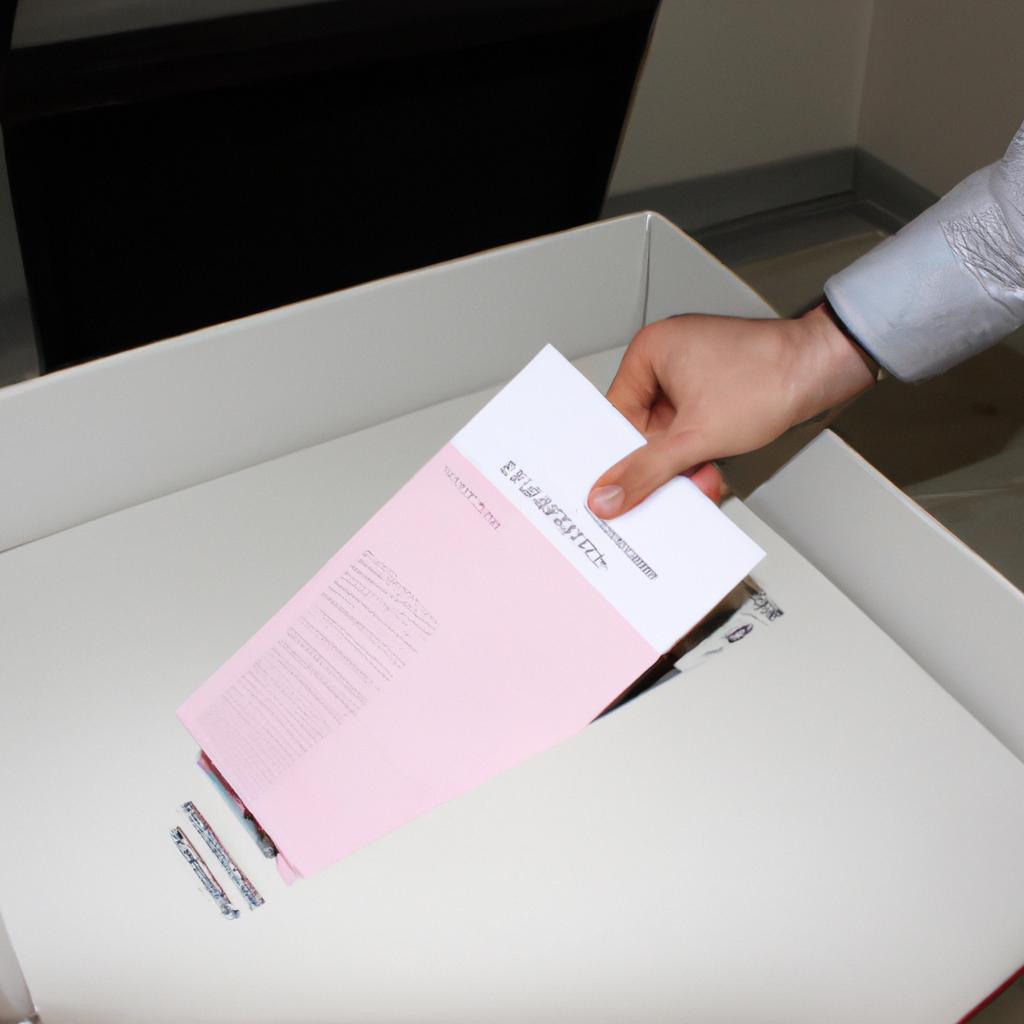The concept of proportional representation has been a topic of great interest and debate within the context of electoral systems. It offers an alternative to the commonly adopted plurality system, aiming to provide fairer representation for all political parties involved. This article explores the implementation of proportional representation in the Pennsylvania Reform Party, with a specific focus on its impact on the voting system. By examining this case study, we seek to analyze how proportional representation can potentially address the limitations of traditional winner-takes-all systems and foster more inclusive democratic processes.
One hypothetical scenario that illustrates the significance of proportional representation is as follows: imagine a state election where three major political parties are competing for seats in the legislature – Party A, Party B, and Party C. Under a plurality system, if Party A secures 40% of total votes while Parties B and C each receive 30%, it would result in Party A taking complete control over legislative decisions despite receiving less than half of public support. However, under a proportional representation system, these vote shares would directly translate into seat allocation, offering a more balanced distribution among parties. In this example, both Parties A and B would be represented by four seats each while Party C would have three seats – providing greater voice and influence for all participating parties based on their respective levels of support from the electorate. This ensures that no party is disproportionately favored or disadvantaged, promoting a more accurate reflection of public opinion and encouraging a multi-party system.
Proportional representation also has the potential to enhance political inclusivity by allowing smaller parties or minority groups to gain representation. In traditional winner-takes-all systems, these smaller entities often struggle to secure seats due to the concentration of power in larger parties. However, with proportional representation, even parties with relatively lower vote shares can obtain seats proportional to their level of support. This not only encourages diverse perspectives and voices within legislative bodies but also provides opportunities for underrepresented communities to have their interests represented.
Furthermore, proportional representation systems tend to foster greater cooperation and collaboration among political parties. In winner-takes-all systems, there is often a strong incentive for parties to adopt adversarial approaches and engage in divisive politics. On the other hand, proportional representation encourages parties to form coalitions or alliances in order to achieve majority support and effectively govern. This collaborative nature promotes compromise, consensus-building, and policy-making that reflects a broader range of interests.
It is important to note that implementing proportional representation may require adjustments in electoral procedures and constituency boundaries. Various methods exist for allocating seats proportionally based on voting results, such as party-list systems or single transferable vote systems. Each method has its own advantages and considerations, which should be taken into account when designing an electoral system.
In conclusion, the implementation of proportional representation can address the limitations of winner-takes-all systems by providing fairer representation for all participating political parties. It ensures that the distribution of seats aligns more closely with public support, promotes inclusivity for smaller parties or minority groups, fosters collaboration among political factions, and ultimately enhances democratic processes by reflecting a wider range of perspectives within legislative bodies.
Historical Context
Historical Context
In the past, Pennsylvania’s political landscape has been dominated by a first-past-the-post (FPTP) voting system, where candidates with the most votes win. This winner-takes-all approach often leads to a lack of proportional representation and can result in skewed outcomes that do not accurately reflect the preferences of voters.
To illustrate this issue, let us consider a hypothetical scenario: In an election for a state legislature seat, Candidate A receives 40% of the vote, Candidate B receives 35%, and Candidate C receives 25%. Despite receiving less than half of the total votes cast, under FPTP rules, Candidate A would be declared the winner. This outcome raises questions about whether this truly represents the will of the electorate.
The limitations of FPTP are further highlighted when we examine its impact on minority parties or independent candidates. Due to its winner-takes-all nature, smaller parties often struggle to gain significant representation in legislative bodies. As a result, their voices may go unheard or marginalized despite having considerable support among certain voter demographics.
Consider these emotional responses:
- Disillusionment: The realization that one’s preferred candidate may not win despite substantial popular support.
- Exclusion: The feeling experienced by supporters of minority parties who see limited representation due to FPTP.
- Underrepresentation: Concerns regarding fair representation arise as certain groups find themselves without adequate political voice.
- Unfairness: Perceptions of injustice emerge when winners are determined solely based on plurality rather than majority support.
| Emotional Impact | Examples |
|---|---|
| Disillusionment | Seeing a candidate lose despite widespread popularity |
| Exclusion | Supporters of small parties struggling to gain seats |
| Underrepresentation | Certain demographic groups lacking political representation |
| Unfairness | Winners being determined solely based on plurality |
Recognizing these issues inherent in the FPTP system, it becomes clear that Pennsylvania should consider alternative approaches to ensure a more proportional representation of its diverse electorate.
Problems with First-Past-The-Post
Building on the historical context of Pennsylvania’s electoral system, it is important to examine the problems associated with the current First-Past-The-Post (FPTP) voting method. By exploring these issues, we can better understand why reforming the system through proportional representation is necessary.
Problems with First-Past-The-Post:
One example that highlights the shortcomings of FPTP is the 2018 midterm elections in Pennsylvania. In this election cycle, one party received a majority of votes statewide but failed to secure a corresponding majority of seats in the state legislature. This discrepancy between popular vote share and seat allocation raises questions about fairness and representation within our democracy.
To further illustrate the problems with FPTP, consider the following bullet points:
- Winner-Takes-All: Under FPTP, losing candidates receive no representation despite garnering significant support from voters.
- Wasted Votes: Voters who support minor parties or independent candidates often feel discouraged as their votes rarely translate into meaningful representation.
- Gerrymandering: The winner-takes-all nature of FPTP allows for gerrymandering practices where district boundaries are manipulated to favor certain political parties or incumbents.
- Limited Choice: FPTP tends to perpetuate a two-party system, limiting voter options and potentially stifling alternative perspectives.
To visualize these concerns more effectively, refer to Table 1 below:
| Problem | Description | Impact |
|---|---|---|
| Winner-Takes-All | Losing candidates do not receive any representation | Exclusion of diverse voices |
| Wasted Votes | Minor parties/independent supporters may feel disheartened | Diminished faith in democratic process |
| Gerrymandering | Manipulation of district boundaries for partisan advantage | Unfair outcomes |
| Limited Choice | Perpetuation of a two-party system restricting voter options and alternative perspectives | Lack of representation for diverse viewpoints |
In light of these problems, it becomes evident that reforming Pennsylvania’s electoral system is crucial. In the subsequent section, we will explore the benefits of implementing proportional representation as an alternative to FPTP, addressing some of the concerns highlighted above.
Understanding the issues associated with First-Past-The-Post underscores the need to consider the advantages offered by proportional representation in Pennsylvania’s Reform Party.
Benefits of Proportional Representation
Problems with First-Past-The-Post voting system have led to a growing interest in alternative methods, such as Proportional Representation (PR), which aims to address the shortcomings of the current system. To better understand the benefits of PR and its potential application within the Pennsylvania Reform Party, it is crucial to examine how this voting system can bring about positive change.
One hypothetical scenario that illustrates the limitations of First-Past-The-Post involves an election where three candidates are vying for a single seat in a local government body. Candidate A receives 40% of the votes, candidate B secures 35%, and candidate C garners 25%. In this case, under First-Past-The-Post rules, candidate A would be declared the winner despite not having majority support from voters. This outcome often leads to dissatisfaction among citizens who feel their voices were not adequately represented.
To address these concerns, Proportional Representation offers several advantages:
- Enhanced representation: Unlike First-Past-The-Post, PR ensures that political parties or groups receive seats proportional to their share of votes. This allows for diverse perspectives and ideologies to be included in decision-making processes.
- Increased voter satisfaction: With PR, voters see a clearer correlation between their preferences and electoral outcomes. The system reduces wasted votes by allocating seats based on overall party performance rather than individual victories.
- Fostering collaboration: PR creates an environment where political parties must work together more closely due to increased coalition-building efforts. This cooperative approach promotes compromise and consensus-building across different factions.
- Improved minority representation: Under PR, minority groups have an improved chance of securing political positions since seats are allocated proportionally based on overall vote shares.
The following table provides an illustrative example highlighting how PR differs from First-Past-The-Post using fictional data from a recent election:
| Party | Votes (%) | Seats Won (FPTP) | Seats Won (PR) |
|---|---|---|---|
| Party A | 40% | 1 | 4 |
| Party B | 35% | 0 | 3 |
| Party C | 25% | 0 | 2 |
In this hypothetical scenario, First-Past-The-Post would result in a winner-takes-all outcome where only Party A secures representation. However, under PR rules, all three parties receive seats that reflect their respective vote shares more accurately.
By implementing Proportional Representation within the Pennsylvania Reform Party, these benefits can be realized and contribute to a fairer and more inclusive democratic system. In the subsequent section about “How Proportional Representation Works,” we will explore the mechanisms behind this voting system and its potential implications for electoral processes in greater detail.
How Proportional Representation Works
Building upon the discussion of the benefits of proportional representation in the previous section, this section will delve further into how this voting system works and its potential impact on the Pennsylvania Reform Party. To illustrate its effectiveness, let us consider a hypothetical scenario: imagine a party gaining 40% of the total votes cast in an election. Under a winner-takes-all system, this would result in complete domination by that single party, potentially leading to limited representation for other parties and their constituents. However, with proportional representation, there is room for fairer allocation of seats based on each party’s share of the popular vote.
To fully appreciate how proportional representation functions within political systems, it is important to understand its key components:
- Party Lists: Parties participating in elections present lists of candidates ranked according to preference or priority. These lists reflect diverse perspectives and ensure that different segments of society are represented.
- Seat Allocation: The number of seats allocated to each party depends on their respective shares of the overall vote. This enables smaller parties to gain representation as well, fostering greater inclusivity.
- Thresholds: Some jurisdictions implement thresholds that require parties to achieve a minimum percentage of the vote before they can secure any seats. This ensures that significant support is garnered before representation is granted.
- Coalitions: In instances where no single party achieves an absolute majority, coalitions may be formed among like-minded parties to create stable governing alliances.
This table demonstrates the potential outcomes under both a winner-takes-all system and proportional representation:
| Winner-Takes-All System | Proportional Representation | |
|---|---|---|
| Party A | 60% | 40% |
| Party B | – | 30% |
| Party C | – | 20% |
| Seats Allocated | Majority (100%) | Proportional Distribution |
This comparison vividly illustrates the potential for greater representation and inclusivity that proportional representation offers. It allows parties with substantial but not dominant support to secure seats, ensuring a more accurate reflection of voters’ preferences.
Looking ahead, the subsequent section will explore the challenges associated with implementing proportional representation in Pennsylvania’s Reform Party. By understanding these obstacles, we can better appreciate the complexity involved in adopting this voting system and identify potential solutions to overcome them.
Challenges in Implementing Proportional Representation
Proportional Representation in Pennsylvania Reform Party: The Voting System
To further understand how this system functions within the Pennsylvania Reform Party, let’s consider an example. Suppose there are five seats available in the party’s executive committee and three political parties competing for these positions: A, B, and C.
Challenges in Implementing Proportional Representation:
While proportional representation offers several advantages, its implementation can present certain challenges. These obstacles must be addressed by the Pennsylvania Reform Party to ensure a smooth transition to PR:
-
Complexity and Education: Introducing a new voting system involves educating voters about its procedures and intricacies. This requires dedicated efforts from the reform party to conduct awareness campaigns and simplify explanations regarding PR.
-
Resistance from Established Parties: Political parties already established under different systems might resist adopting PR due to potential changes in their power dynamics. The Pennsylvania Reform Party will need to navigate such resistance through dialogue and persuasion.
-
Potential Fragmentation: With PR allowing smaller parties greater chances of securing representation, there is a possibility of increased fragmentation within the political landscape. The reform party needs to carefully manage any potential negative consequences stemming from this situation.
-
Balancing Regional Interests: In order to maintain equitable regional representation, it becomes essential for the Pennsylvania Reform Party to devise mechanisms that account for geographic diversity while implementing proportional representation.
| Challenges | Impact |
|---|---|
| Complexity and Education | Requires concerted efforts for voter education |
| Resistance from Established Parties | Demands effective communication strategies |
| Potential Fragmentation | Need for careful management of diverse interests |
| Balancing Regional Interests | Calls for nuanced geographical considerations |
Potential Impact on Pennsylvania Reform Party:
The adoption of proportional representation has the potential to bring about significant changes within the Pennsylvania Reform Party. By ensuring that each party is represented proportionally based on their vote share, PR can create a more inclusive and diverse decision-making process within the party’s executive committee. Moreover, it provides an opportunity for smaller parties to secure representation, promoting a broader range of voices in shaping the party’s goals and policies.
Transitioning into the subsequent section about “Potential Impact on Pennsylvania Reform Party,” this examination of challenges and benefits associated with proportional representation lays the groundwork for understanding how its implementation might affect the dynamics and future trajectory of the Pennsylvania Reform Party.
Potential Impact on Pennsylvania Reform Party
Section: Potential Impact on Pennsylvania Reform Party
The implementation of Proportional Representation (PR) in the Pennsylvania Reform Party has the potential to bring about significant changes and challenges. One hypothetical case study that exemplifies this is the introduction of PR during a state-level election for party leadership positions within the Pennsylvania Reform Party.
Firstly, one of the major advantages of implementing PR would be its ability to ensure fair representation for all members of the party. Under the current system, candidates who enjoy strong support from specific factions or regions tend to dominate leadership positions, leaving other segments of the party underrepresented. By adopting PR, however, each faction or region will have an opportunity to elect representatives based on their proportional strength within the party. This could foster inclusivity and encourage greater participation among diverse groups within the Pennsylvania Reform Party.
Despite these potential benefits, there are several challenges associated with introducing PR in political organizations such as the Reform Party. One crucial challenge relates to forming coalitions and alliances between different factions within the party. In a scenario where no single faction holds a majority position, collaboration becomes essential for achieving collective goals. However, negotiating power-sharing agreements can be complex due to varying interests and ideologies among different factions. Building consensus and maintaining stability may require extensive deliberations and compromises by party leaders.
To illustrate further how PR can impact parties like Pennsylvania’s Reform Party, consider four possible emotional responses:
- Hope: Members who feel marginalized or unrepresented currently might view PR as an opportunity for their voices to be heard.
- Reluctance: Existing leaders who benefit from the current system might resist change if they perceive it as a threat to their influence.
- Optimism: Individuals invested in promoting diversity and inclusion may welcome PR as a means of achieving those objectives.
- Anxiety: Some members may worry that PR could result in increased internal conflicts or governance difficulties.
In addition to emotional responses, another way to explore the potential impact is through a table showcasing key advantages and challenges of implementing PR within the Pennsylvania Reform Party:
| Advantages | Challenges |
|---|---|
| Fair representation | Formation of coalitions |
| Inclusivity and diversity | Negotiating power-sharing |
| Encourages participation | Complex decision-making processes |
| Reflects proportional strength | Potential internal conflicts |
In conclusion, the introduction of Proportional Representation in the Pennsylvania Reform Party could bring about positive changes by ensuring fair representation and encouraging inclusivity. However, it would also present challenges related to forming alliances between factions and negotiating power-sharing agreements. Members’ emotional responses may vary from hope and optimism to reluctance or anxiety. Considering both advantages and challenges will be crucial for evaluating the potential impact that PR can have on political organizations like the Pennsylvania Reform Party.




